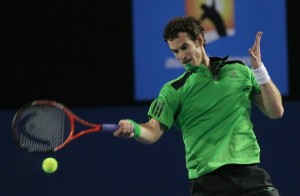One set of statistics don’t tell the entire story of Andy Murray’s ascent to the Australian Open final, but they go a long way toward explaining not only why Murray is into his third Grand Slam final but also how he has taken his game up one more crucial notch.
In this 4-6, 7-6 (2), 6-1, 7-6 (2) victory over David Ferrer, the new, more aggressive Murray had 60 winners and 63 unforced errors — a quantum jump from the, say, 20 winners and 18 unforced errors Murray would typically run up in his previous life.
This has been a work in progress for Murray for most of the last year, playing with more risk, finding the right balance and the right time to modulate his tennis between full-tilt aggression and defense/counterpunching.

For years, it was Murray’s considerable talent to beat you not with winners but by forcing errors, and there was no one better at it. But he’d get to the late rounds of a major tournament to find that you can’t out-steady the best players in the game.
He’s had to learn not only to be more aggressive, but when to be more aggressive. He can’t be Robin Soderling out there, playing scorched earth. He has to mix it up, and it’s not always easy to find the right moment to be passive and the right time to go into overdrive.
I think he’s found it and he’ll go into Sunday’s final against Novak Djokovic with high confidence and, I think, a decided edge if the weather is going to be as hot as forecast.
Djokovic holds a 4-3 head-to-head edge, but that’s a bit deceptive. They’re 3-3 on hardcourts with Murray winning the last three, all in straight sets.
They’ve never played each other in a major and they haven’t been on court together since the 2009 final at Key Biscayne, won by Andy 6-2, 7-5.
That, too, was a very warm day and Djokovic needed a trainer on-court at one point to deal with what appeared to be heat sickness. Afterward, he acknowledged how difficult it is for him to deal with hot conditions. That was nearly two years ago. One would think Djokovic has improved his fitness since, though if you have trouble breathing in hot weather, I’m not sure if there is an antidote.
Friday in Melbourne, he and Ferrer played the night match and it was cool, though after a disappointing start, Murray got a lot warmer. He had begun this match in a more passive mood, but switched on the aggression in the second set, won easily in the tiebreak and roared through the third with 71 percent first serves in — very high for Murray.
He picked up an early break in the fourth, but gave it right back at love as Ferrer, an indefatigable runner, showed no signs of fatigue.
Murray, of course, is more than just an extremely accurate ground stroker off both sides. He’s got a very dangerous first serve and he’s an exceptional athlete. His defensive skills, combined with his superior court coverage, keep him in a lot of points, and he has that ability to go quickly from defense to offense.
There is still upside to Murray’s game. His second serve could use more pop and, while he’s a willing volleyer now, he sometimes lacks full concentration at the net.
Late in the match, Murray popped a lob over the drawn-in Ferrer, who went back, retrieved and hit a ball directly at Murray. Murray gaffed the volley into the net — an absolute gimme.
This is the first Grand Slam final since the 2008 Australian Open (Djokovic vs. Jo-Wilfried Tsonga) where one of the participants wasn’t named Nadal or Federer. And the last final before that without Federer or Nadal was the 2005 Australian (Marat Safin vs. Lleyton Hewitt).
It’s the fourth major final for Djokovic, who lost to Rafa Nadal in four at last year’s U.S. Open, beat Tsonga in 2008 and lost to Roger Federer at the 2007 U.S. Open.
It’s the third major final for Murray, who lost to Federer at both the 2008 U.S. Open and 2010 Australian Open.
Murray is trying to become the first British man to win a Grand Slam singles titles since Fred Perry 75 years ago.
